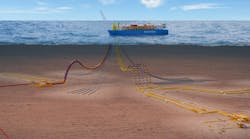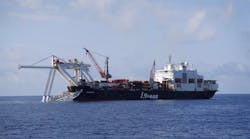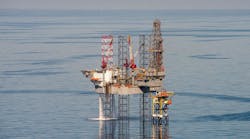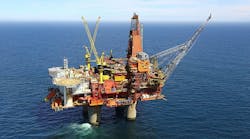Deepstar CT tests show 80% reduction in clearance costs
John R. Illeman
Elf Exploration
DeepStar Pipeline Blockage Remediation Committee
Startac combines a thruster pig and skate system to reduce drag on coiled tubing and allow successful paraffin remediation as far as 5 miles from a platform.A DeepStar Flow Assurance sub-committee, set up in early 1996, took on the task of designing a project to clear wax and hydrate blockages from subsea deepwater pipelines without damaging the pipeline. Another goal was for all equipment to be removed from the line, even after a possible equipment failure.
Advanced coiled tubing technology was used to reach five miles into a pipeline. Previous coiled tubing pipeline clean-out operations generally could not penetrate into pipelines any further than a mile due to friction and sinusoidal and helical buckling.
Why five miles? Most pipeline blockages occur within five miles of a well or production facility. As the oil cools off in the cold deepwater environment and the cloud point is reached, wax begins to form, which sticks to the pipe, eventually resulting in a blockage. A method to clear these blockages could save oil producers millions of dollars in replacement pipelines and downtime. Production facilities could be designed to remediate blockages from the facility through the pipeline riser using coiled tubing. Another advantage to this solution is the opportunity for vessel-based coiled tubing units to gain access for remediation work through the subsea well, manifold, or an intermediate pipeline entry points.
Radoil Tool Co. was selected as the prime contractor for the project. Radoil constructed a pipeline testing loop, about 900 ft in length with a 6 5/8-in. OD, and a degree of difficulty modeled to simulate a 5,000 ft pipeline. The company also constructed a standardized pipeline test facility with the necessary access and tools to allow vendors to test their equipment in the loop.
For these tests, a standardized wax plug and hydrate plug were developed. The procedure for the pipeline loop testing by the vendors included:
- Navigation through the entire test loop
- Disassociation of the wax and hydrate blockages
- Suspension of the wax and hydrate blockages
- Removal of these blockages from the loop
- Exiting from the loop.
Plugging away
Next, a standardized wax mixture was prepared using 70% wax from a vacuum tower bottom (Flying J refinery - Salt Lake City, Utah) and 30% wax (Shell's Ship Shoal 274 field). A 15-ft spool section was added to the end of the flowloop which contained the wax plugs. It was found that a hydrate plug could be generated in the flowloop by a controlled bubbling of methane gas through water under pressure.Friction testing was done by Radoil to determine the design criteria for the flowloop to simulate five miles. Small scale testing was done using a 3/8-in. tube inside a l-in. nominal pipe. Friction forces were evaluated in the pipe along with the effects of 90° bends.
Radoil completed building the 6-in. flowloop in the spring of 1997, and DeepStar, in conjunction with Radoil, began to solicit vendors to begin testing extended reach coiled tubing equipment. To simulate five miles, the flowloop was built with four 25-ft radius bends. The flowloop is approximately 900 ft long and has a deployment building which contains both the necessary equipment to deploy the coiled tubing, along with the wax and hydrate spool sections at the end of the flowloop. Both ends of the flowloop are in the deployment building.
Ambar develops skate
Little response was received from the coiled tubing vendors to test in the flowloop. Because of the demand for coiled tubing equipment and personnel on actual jobs, many vendors could not spare the equipment, personnel, or time for flowloop testing. Two companies did step up to solve the goals of this project.Ambar Production Services worked on and developed a skate system that could be attached to the coiled tubing. The skates kept the coiled tubing centralized inside the flowloop and not only reduced pipe friction by 80-85%, but also reduced its tendency to buckle.
With the skates attached, the coiled tubing was easily pushed all the way through the simulated five mile flowloop. The skates were bolted onto the coiled tubing as it entered the flowloop, and then snubbed in with a snubbing apparatus. Tests showed that this method could allow the 1 1/4-in. coiled tubing to penetrate upwards of 40,000 ft (7.5 miles), into a 6-in. pipeline, even when the pipeline was under pressure.
To remove the wax plug in the flowloop, Ambar attached a jetting tool to the end of the coiled tubing. This allowed high pressure liquid to be pumped into the coiled tubing to jet out the wax blockages. The returns were taken back through the annulus of the flowloop to the return tanks.
The tool nozzle jets from not only the end, but also to the sides, cleaning the pipe as it goes. The jetting fluid may be water, diesel, paraffin chemicals or hot fluids. Ambar used a combination solvent and dispersant, along with the jetting turbulence, to dissolve the wax plug in the flowloop. This was very effective and easily cleaned the pipe to bare metal.
Pulling with a pig
Radoil developed a thruster pig system that attached to the coiled tubing and developed up to 30,000 lb thrust with only 1,000 psi differential pressure. This allows the coiled tubing to be pulled into the pipeline instead of being pushed in. Pulling the coiled tubing greatly reduced its tendency to buckle, and allowed greater penetration. Tests showed 1 1/4 in. coiled tubing, with both Radoil's thruster pig system and Ambar's skate system attached, could achieve upwards of 100,000 ft penetration into a 6-in. pipeline.To jet and circulate out the wax plug with the pig system attached, Radoil and Ambar designed a check valve system that allowed fluid to be pumped through the coiled tubing, out the jet nozzle, into the annulus of the flowloop, back through the check valves, around (through) the pig, and back through the annulus to the return tanks.
If the tools become stuck in the pipeline, Ambar has a releasing sub that can be attached just above the tools. The coiled tubing can then be disconnected at the sub and pulled out, leaving a fishing neck behind. Later, the coiled tubing can be reinserted to retrieve the tools using standard fishing tools.
Results
Several producers are currently very interested in field testing these systems sometime in early 1998. DeepStar is eager to work with them in coordinating the work and to help defer some of the expenses. The fulfillment of the field testing phase will complete the goals of the DeepStar flow assurance subcommittee.Ambar Production Services now has purchased the exclusive rights for the use of this system, including, but not limited to the skates, the thruster pig, and all support equipment. These products will be marketed under the trade name of Startac. Consultant Jim Bob Crawford who represented Ambar on the project said interest in this system was immediate.
Because the project was funded by DeepStar, all 22 members had access to the information. Many wanted to put this new technology to use, Crawford said. From a cost standpoint, the attention is understandable.
One job being considered would cost over $1 million using conventional methods, such as raising the pipe to clear it. Using the newly developed Startac system, the cost would be closer to $150,000. Crawford said he expects to begin the first field work of this system within the next month.
Author
John R. Illeman is a production superintendent for Elf Exploration, and also chairman of the Pipeline Blockage Remediation Committee for the Deepstar joint industry program.Copyright 1998 Oil & Gas Journal. All Rights Reserved.






